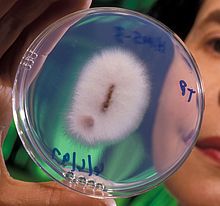
Fusarium oxysporum f.sp. cubense

Fusarium oxysporum f.sp. cubense Pronunciation (help·info) is a fungal plant pathogen that causes Panama disease of banana (Musa spp.), also known as fusarium wilt of banana. Although fruit of the wild bananas (Musa spp.) have large, hard seeds, most edible bananas are seedless. Banana plants are therefore propagated asexually from offshoots. Because these rhizomes are usually free of symptoms even when the plant is infected by F. oxysporum f. sp. cubense, they are a common means by which this pathogen is disseminated. It can also be spread in soil and running water, on farm implements or machinery. Panama disease is one of the most destructive plant diseases of modern times. It is believed to have originated in Southeast Asia and was first reported in Australia in 1876. By 1950 it had spread to all the banana-producing regions of the world with the exception of some islands in the South Pacific, the Mediterranean, Melanesia and Somalia. Panama disease affects a wide range of banana cultivars; however, it is best known for the damage it caused to a single cultivar in the early export plantations. Before 1960, a total reliance was put on the cultivar 'Gros Michel', and it supplied almost all the export trade. It proved susceptible to the disease and the use of infected rhizomes to establish new plantations caused widespread and severe losses. Some indication of the scale of the losses is demonstrated by the complete eradication of production on 30,000 hectares of plantation in the Ulua Valley of Honduras between 1940 and 1960. In Suriname, an entire operation of 4,000 hectares was out of business within eight years and in the Quepos area of Costa Rica, 6,000 hectares were destroyed in twelve years. By the mid-1900s, resistant cultivars in the 'Cavendish' subgroup were being used as a substitute for 'Gros Michel' in the export trade. These cultivars have proved resilient and grow well in the western tropics, remaining the clones on which the current export trades are based. Unfortunately, in several growing areas in the Eastern Hemisphere these cultivars are susceptible to the disease. It is considered inevitable that this susceptibility will spread to the Western Hemisphere, and this poses a significant threat to production because there are currently no acceptable replacement cultivars. To make things worse, this variant of the pathogen also affects plantains, Musa acuminata × balbisiana, which are an important staple food in tropical regions of the world. The average American eats 26.2 pounds of the Cavendish banana each year and the question is being asked as to whether this oft-consumed fruit is on course to extinction. Apart from the export trade, 85% of banana production is for local consumption and many of the cultivars used for this purpose are also susceptible to infection. Fusarium oxysporum is a common inhabitant of soil and produces three types of asexual spores; macroconidia, microconidia and chlamydospores. The macroconidia are nearly straight, slender and thin-walled. They usually have three or four septa, a foot-shaped basal cell and a curved and tapered apical cell. They are generally produced from phialides on conidiophores by basipetal division. They are important in secondary infection.
